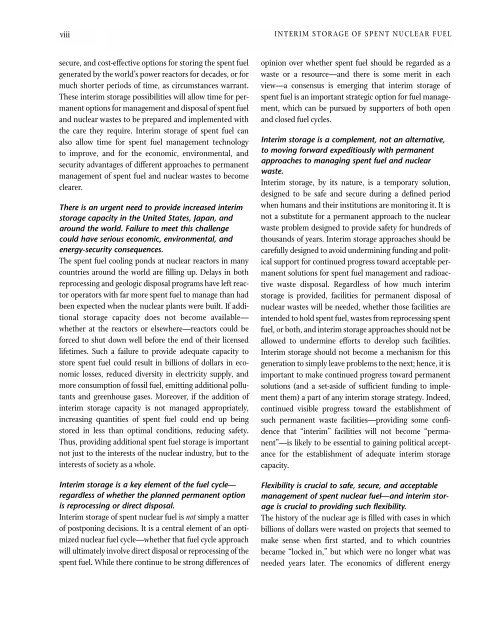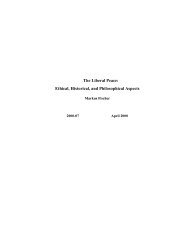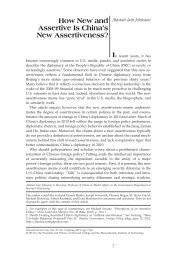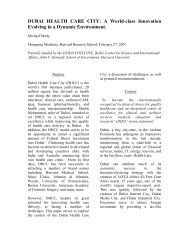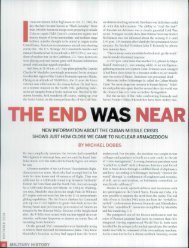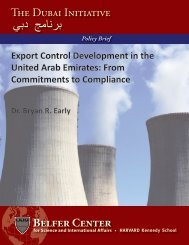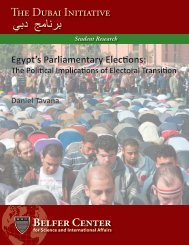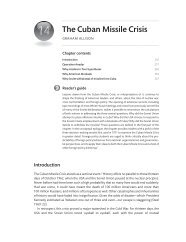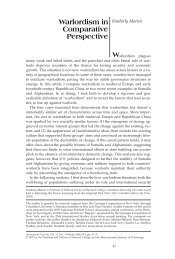Interim Storage of Spent Nuclear Fuel - Woods Hole Research Center
Interim Storage of Spent Nuclear Fuel - Woods Hole Research Center
Interim Storage of Spent Nuclear Fuel - Woods Hole Research Center
Create successful ePaper yourself
Turn your PDF publications into a flip-book with our unique Google optimized e-Paper software.
viii<br />
secure, and cost-effective options for storing the spent fuel<br />
generated by the world’s power reactors for decades, or for<br />
much shorter periods <strong>of</strong> time, as circumstances warrant.<br />
These interim storage possibilities will allow time for permanent<br />
options for management and disposal <strong>of</strong> spent fuel<br />
and nuclear wastes to be prepared and implemented with<br />
the care they require. <strong>Interim</strong> storage <strong>of</strong> spent fuel can<br />
also allow time for spent fuel management technology<br />
to improve, and for the economic, environmental, and<br />
security advantages <strong>of</strong> different approaches to permanent<br />
management <strong>of</strong> spent fuel and nuclear wastes to become<br />
clearer.<br />
There is an urgent need to provide increased interim<br />
storage capacity in the United States, Japan, and<br />
around the world. Failure to meet this challenge<br />
could have serious economic, environmental, and<br />
energy-security consequences.<br />
The spent fuel cooling ponds at nuclear reactors in many<br />
countries around the world are filling up. Delays in both<br />
reprocessing and geologic disposal programs have left reactor<br />
operators with far more spent fuel to manage than had<br />
been expected when the nuclear plants were built. If additional<br />
storage capacity does not become available—<br />
whether at the reactors or elsewhere—reactors could be<br />
forced to shut down well before the end <strong>of</strong> their licensed<br />
lifetimes. Such a failure to provide adequate capacity to<br />
store spent fuel could result in billions <strong>of</strong> dollars in economic<br />
losses, reduced diversity in electricity supply, and<br />
more consumption <strong>of</strong> fossil fuel, emitting additional pollutants<br />
and greenhouse gases. Moreover, if the addition <strong>of</strong><br />
interim storage capacity is not managed appropriately,<br />
increasing quantities <strong>of</strong> spent fuel could end up being<br />
stored in less than optimal conditions, reducing safety.<br />
Thus, providing additional spent fuel storage is important<br />
not just to the interests <strong>of</strong> the nuclear industry, but to the<br />
interests <strong>of</strong> society as a whole.<br />
<strong>Interim</strong> storage is a key element <strong>of</strong> the fuel cycle—<br />
regardless <strong>of</strong> whether the planned permanent option<br />
is reprocessing or direct disposal.<br />
<strong>Interim</strong> storage <strong>of</strong> spent nuclear fuel is not simply a matter<br />
<strong>of</strong> postponing decisions. It is a central element <strong>of</strong> an optimized<br />
nuclear fuel cycle—whether that fuel cycle approach<br />
will ultimately involve direct disposal or reprocessing <strong>of</strong> the<br />
spent fuel. While there continue to be strong differences <strong>of</strong><br />
INTERIM STORAGE OF SPENT NUCLEAR FUEL<br />
opinion over whether spent fuel should be regarded as a<br />
waste or a resource—and there is some merit in each<br />
view—a consensus is emerging that interim storage <strong>of</strong><br />
spent fuel is an important strategic option for fuel management,<br />
which can be pursued by supporters <strong>of</strong> both open<br />
and closed fuel cycles.<br />
<strong>Interim</strong> storage is a complement, not an alternative,<br />
to moving forward expeditiously with permanent<br />
approaches to managing spent fuel and nuclear<br />
waste.<br />
<strong>Interim</strong> storage, by its nature, is a temporary solution,<br />
designed to be safe and secure during a defined period<br />
when humans and their institutions are monitoring it. It is<br />
not a substitute for a permanent approach to the nuclear<br />
waste problem designed to provide safety for hundreds <strong>of</strong><br />
thousands <strong>of</strong> years. <strong>Interim</strong> storage approaches should be<br />
carefully designed to avoid undermining funding and political<br />
support for continued progress toward acceptable permanent<br />
solutions for spent fuel management and radioactive<br />
waste disposal. Regardless <strong>of</strong> how much interim<br />
storage is provided, facilities for permanent disposal <strong>of</strong><br />
nuclear wastes will be needed, whether those facilities are<br />
intended to hold spent fuel, wastes from reprocessing spent<br />
fuel, or both, and interim storage approaches should not be<br />
allowed to undermine efforts to develop such facilities.<br />
<strong>Interim</strong> storage should not become a mechanism for this<br />
generation to simply leave problems to the next; hence, it is<br />
important to make continued progress toward permanent<br />
solutions (and a set-aside <strong>of</strong> sufficient funding to implement<br />
them) a part <strong>of</strong> any interim storage strategy. Indeed,<br />
continued visible progress toward the establishment <strong>of</strong><br />
such permanent waste facilities—providing some confidence<br />
that “interim” facilities will not become “permanent”—is<br />
likely to be essential to gaining political acceptance<br />
for the establishment <strong>of</strong> adequate interim storage<br />
capacity.<br />
Flexibility is crucial to safe, secure, and acceptable<br />
management <strong>of</strong> spent nuclear fuel—and interim storage<br />
is crucial to providing such flexibility.<br />
The history <strong>of</strong> the nuclear age is filled with cases in which<br />
billions <strong>of</strong> dollars were wasted on projects that seemed to<br />
make sense when first started, and to which countries<br />
became “locked in,” but which were no longer what was<br />
needed years later. The economics <strong>of</strong> different energy


